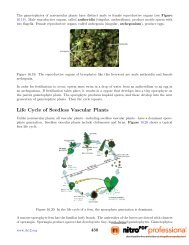Chapter 23 The Circulatory, Respiratory, Digestive, and Excretory ...
Chapter 23 The Circulatory, Respiratory, Digestive, and Excretory ...
Chapter 23 The Circulatory, Respiratory, Digestive, and Excretory ...
You also want an ePaper? Increase the reach of your titles
YUMPU automatically turns print PDFs into web optimized ePapers that Google loves.
Table <strong>23</strong>.1: (continued)<br />
Enzyme What It Digests Where It Is Made<br />
Peptidase proteins duodenum<br />
<strong>The</strong> liver is an organ of both digestion <strong>and</strong> excretion. It produces a fluid called bile, which is secreted<br />
into the duodenum. Some bile also goes to the gall bladder, a sac-like organ that stores <strong>and</strong> concentrates<br />
bile <strong>and</strong> then secretes it into the small intestine. In the duodenum, bile breaks up large globules of lipids<br />
into smaller globules that are easier for enzymes to break down. Bile also reduces the acidity of food<br />
entering from the highly acidic stomach. This is important because digestive enzymes that work in the<br />
duodenum need a neutral environment. <strong>The</strong> pancreas contributes to the neutral environment by secreting<br />
bicarbonate, a basic substance that neutralizes acid.<br />
Absorption in the Small Intestine<br />
<strong>The</strong> jejunum is the second part of the small intestine, where most nutrients are absorbed into the blood. As<br />
shown in Figure <strong>23</strong>.24, the mucous membrane lining the jejunum is covered with millions of microscopic,<br />
fingerlike projections called villi (singular, villus). Villi contain many capillaries, <strong>and</strong> nutrients pass from<br />
the villi into the bloodstream through the capillaries. Because there are so many villi, they greatly increase<br />
the surface area for absorption. In fact, they make the inner surface of the small intestine as large as<br />
a tennis court! You can watch an animation of absorption across intestinal villi at this link: http:<br />
//www.youtube.com/watch?v=P1sDOJM65Bc&feature=related.<br />
Figure <strong>23</strong>.24: This image shows intestinal villi greatly magnified. <strong>The</strong>y are actually microscopic.<br />
<strong>The</strong> ileum is the third part of the small intestine. A few remaining nutrients are absorbed here. Like the<br />
jejunum, the inner surface of the ileum is covered with villi that increase the surface area for absorption.<br />
<strong>The</strong> Large Intestine <strong>and</strong> Its Functions<br />
From the small intestine, any remaining food wastes pass into the large intestine. <strong>The</strong> large intestine is<br />
a relatively wide tube that connects the small intestine with the anus. Like the small intestine, the large<br />
711 www.ck12.org





